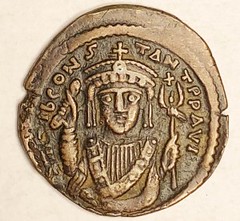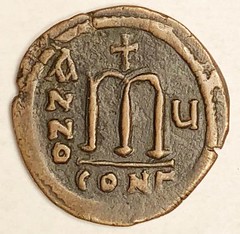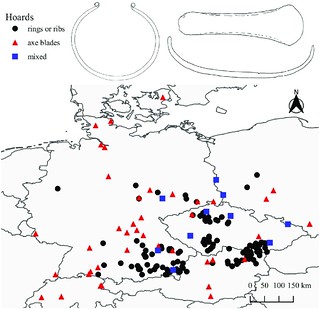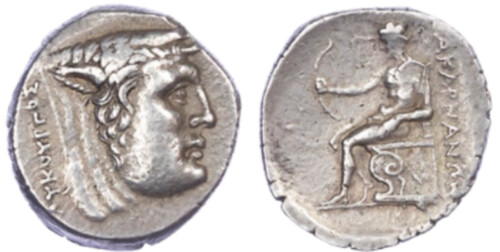
PREV ARTICLE
NEXT ARTICLE
FULL ISSUE
PREV FULL ISSUE
LOOSE CHANGE: NOVEMBER 28, 2021Here are some additional items in the media this week that may be of interest. -Editor Dealer Frank Robinson attended the recent Baltimore Expo and wrote about his experience, including this nice acquisition. -Editor
... a dollar-sized Byzantine bronze of Emperor Tiberius Constantine (578-82 AD). The big M signifies the denomination (follis); the Quality is the name of the game.
To read the complete article, see:
Ted Banning passed along this article on the origins of money. Thanks. -Editor
We calculate the degree of uniformity on the basis of psychophysics, and quantify this using similarity indexes. The analysis shows that 70.3% of all rings could not be perceptibly distinguished from a ring weighing 195.5 grams, indicating their suitability as commodity money. Perceptive weight equivalence is demonstrated between rings, and a selection of ribs and axe blades. Co-occurrence of these objects evidences their interchangeability. We further suggest that producing copies of rings led to recognition of weight similarities and the independent emergence of a system of weighing in Central Europe at the end of the Early Bronze Age.
To read the complete article, see:
This article from the Baldwin's blog discusses a coin motif I've always been curious about - the man-headed bull. Check it out. -Editor Of all the mythical beasts to appear on coins from the ancient world, the man-headed bull must rank among the most bizarre. These strange beasts were usually river-gods, the power of a raging bull equating to the relentless power of a fast-flowing river. Achelous was the chief river-god of the Greek pantheon. Son of the Titans Oceanus and Tethys, he appears in various forms throughout ancient material culture, including a bearded man and a bull, and sometimes a combination of the two. The Achelous river, which formed the border between Akarnania and Aetolia, was the largest river in Greece, thus making the river god the most important in Greek mythology. Coins from Akarnania depict the god in his man-headed bull form, including coin #23 from our Christmas Fixed Price List. This silver stater, minted in Leukas, which was a part of the Akarnanian Confederacy, features a close-up of Achelous' head, clean-shaven and with horns. Behind his head is the name of the magistrate in ancient Greek – ?YKOYPGOS, or Lykourgos. This coin was minted around 250-200 BC. Its reverse depicts the god, Apollo, seated left on an ornately decorated throne, along with the name of the confederacy.
To read the complete article, see:
Wayne Homren, Editor The Numismatic Bibliomania Society is a non-profit organization promoting numismatic literature. See our web site at coinbooks.org. To submit items for publication in The E-Sylum, write to the Editor at this address: whomren@gmail.com To subscribe go to: https://my.binhost.com/lists/listinfo/esylum All Rights Reserved. NBS Home Page Contact the NBS webmaster 
|



